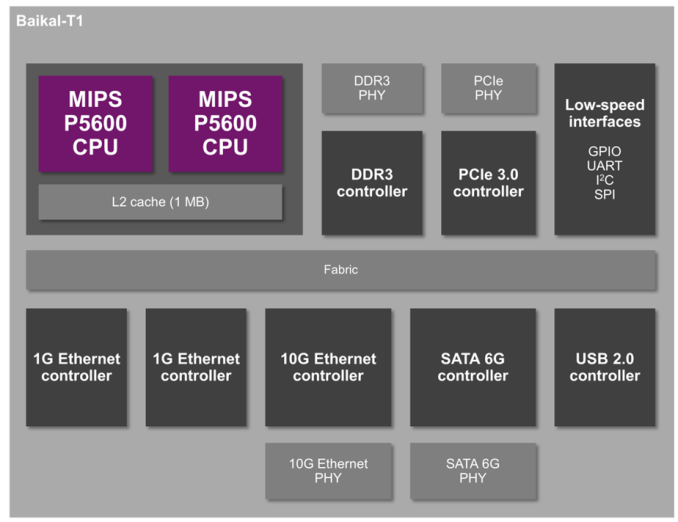Spot the CPU: Russian Baikal-T1 SoC Goes MIPS
by Ian Cutress on May 27, 2015 11:00 AM EST- Posted in
- SoCs
- CPUs
- Imagination Technologies
- MIPS
- Baikal

If you keep your ear to the ground with the technology press, you can’t help but notice a few news stories hitting the ground when it comes to Russia, and a slow progression away from x86 relying on home-grown silicon for enterprise applications. These stories have to be taken with a grain of salt, as sometimes the sources are not the best. However one of our more regular sources of news, Imagination Technologies, has lifted the lid on a press release regarding the implementation of MIPS into a communications based SoC with a Russian fabless semiconductor company.
The SoC at the heart of today’s press release is the Baikal-T1, which uses the dual core MIPS P5600 Warrior CPU at its base, clocked at 1.2 GHz but supporting a fabric that also integrates dual gigabit Ethernet, 10 gigabit Ethernet, SATA 6 Gbps, DDR3 and PCIe 3.0 at once. The 25x25nm package is manufactured on 28nm (TSMC we would assume) for a sub-5W power consumption.
In a world where we discuss smartphone, tablet and notebook SoCs moving to 64-bit, perhaps linking back in to a 32-bit core seems like a regression. Imagination is keen to point out their Enhanced Virtual Addressing for 4GB use and Extended Physical Addressing for 1TB technologies help on this front, as well as enhanced instruction bonding featured in recent generations of Imagination MIPS.
So perhaps a 5W communications processor is not that exciting but it sets a small precedent here. Most of our readers are situated in the west, where x86 and ARM are the key players in anything above 1W. Security concerns regarding backdoor implementations in both designs and algorithms are causing two of the world’s largest superpowers, Russia and China, to pursue other avenues, even if this is via the government or commercial. On the commercial line, nation states will offer contracts to those who can satisfy the criteria, and if the criteria is non-x86 + non-ARM to avoid potential issues, especially when it comes to networking, then commercial will come in to fill the void. To that extent, ELVEES, another Russian SoC semiconductor company, is already using 32-bit and 64-bit MIPS in their designs for video analytics.
Source: Imagination Technologies





_thumb.png)








26 Comments
View All Comments
mmrezaie - Wednesday, May 27, 2015 - link
I am very interested. For whatever reason some researchers have got a fund to develop a processor. This way more people will be educated in these areas and we might see interesting projects happening in the future. But I still don't understand from openness point of view, which architecture is actually completely open source so that others can use it as reference. I think MIPS is open as long as you don't implement part of the ISA! Right?alexvoica - Wednesday, May 27, 2015 - link
MIPS is not completely open from a commercial point of view; you still need to pay a license fee and royalties if you want to build chips. However, MIPSfpga is available for free to universities and students.MIPSfpga is a pre-verified configuration of a MIPS microAptiv CPU that can run Linux; this bundle offers completely open access to the full Verilog RTL code, free tools and and a free SDK:
http://www.anandtech.com/show/9194/imagination-ann...
tipoo - Wednesday, May 27, 2015 - link
Russia is also looking into Transmeta-like processors with x86 emulationhttp://arstechnica.com/gadgets/2015/05/russia-now-...
Nvidias denver was a good reminder of the problem with binary translation systems. Even using a large 128MB memory cache, performance in straightforward applications was great, but fell off a cliff in spaghetti code or multitasking. The translation engine seems to be what choked it up.
These types of processors could certainly have a lot of uses, but translation doesn't always work great.
lilo777 - Wednesday, May 27, 2015 - link
Just want to mention that Transmeta was actually born out of ideas originally developed by Russians in a first place. Here is a link to some info on this story: https://groups.google.com/forum/#!topic/comp.arch/...extide - Wednesday, May 27, 2015 - link
Looks like an interesting chip, got great connectivity, but it seems like it should have some accelerators? Like maybe a packet processor (given the 10G + 2x1G) and an encryption/hash coprocessor is always a good thing these days, although I am not sure if the MIPS arch already has some instructions to speed that stuff up.Looks like this could be a great NAS or Router/Wifi AP chip -- although, especially for the latter, the encryption stuff would be a bit of an issue.
Maybe that stuff is there, but just not being shown in the block diagram? Ehh, probably not.
Wilco1 - Wednesday, May 27, 2015 - link
"Security concerns regarding backdoor implementations in both designs and algorithms are causing two of the world’s largest superpowers, Russia and China, to pursue other avenues"Isn't it ironic that Russia and China are 2 countries which would love to have their own CPUs so they can put in backdoors to enable unlimited spying and repression of their population?
MrSpadge - Wednesday, May 27, 2015 - link
Yeah, not trusting the others doesn't automatically mean you're any better.lilo777 - Wednesday, May 27, 2015 - link
True. It also does not mean that you are worse. The claim that China and Russia want to have their own CPUs in order to " put in backdoors to enable unlimited spying and repression of their population" at the very least is absolutely not substantiated. Just a typical stereotyping on the part of western media/population.toyotabedzrock - Wednesday, May 27, 2015 - link
The difference is that in the west we eventually crack down on over reach instead of changing the law to usher in a dictator.easp - Wednesday, May 27, 2015 - link
We eventually crack down on overreach in the west, until we don't. I'm not too impressed by the slow pace of reforming the reach of the US's domestic intelligence.